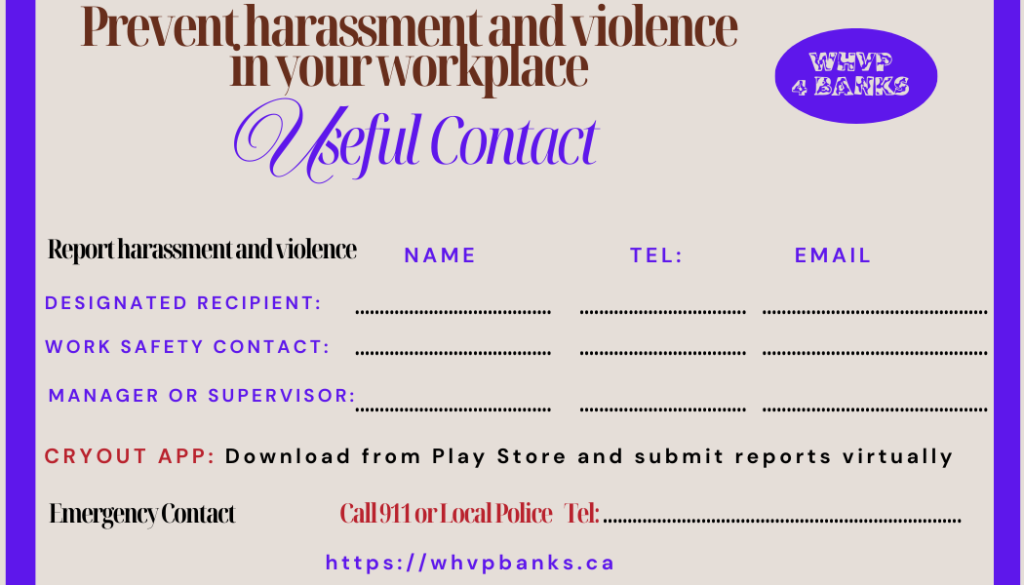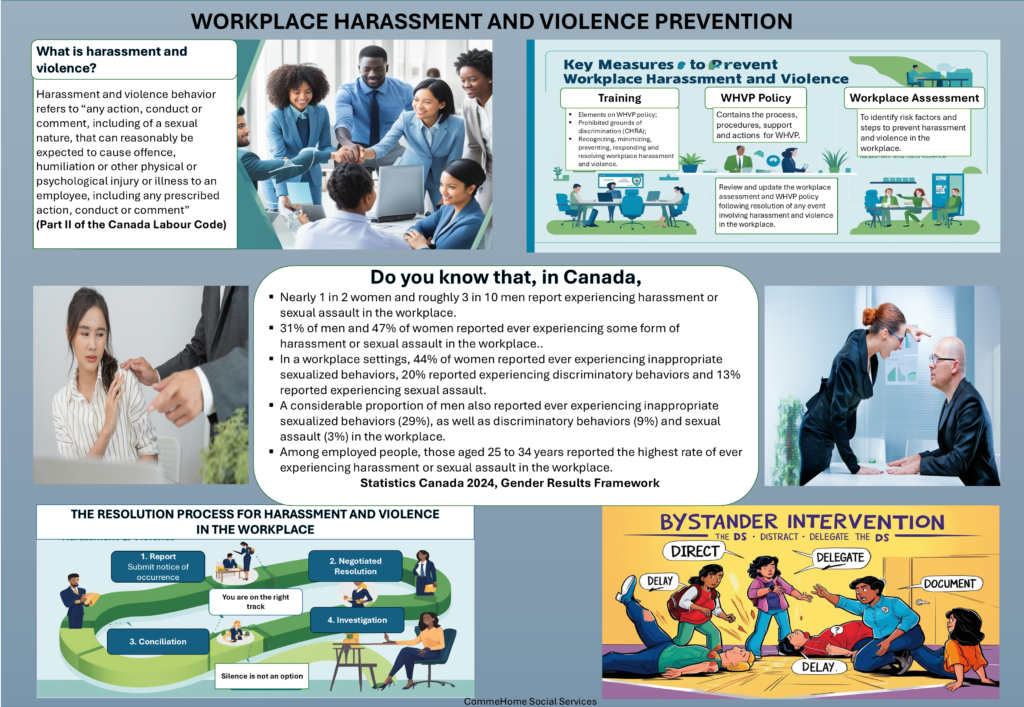WHVP RESOURCES
The Act to amend the Canada Labour Code (CLC) also known as Bill C-65, received Royal Assent in October 2018. The Act introduces multiple amendments to the Canada Labour Code including sexual harassment and sexual violence, so as to strengthen the existing framework for harassment and violence prevention. The amendments to the Canada Labour Code came into force on January 1, 2021 alongside with the new Workplace Harassment and Violence Prevention Regulations.
Here are some useful tools and resources developed by the WHVP team to strengthen your understanding of the prevention of harassment and violence in the workplace.
WHVP Resource Guide
This guide provides an overview of available resources on workplace harassment and violence prevention. The resources include:
- Self-paced online courses to enhance knowledge and understanding of harassment and violence prevention in the workplace. Please use this link to access the courses. (Link).
- The CryOut app to facilitate reporting of events involving harassment and violence in the workplace. Employers must register to receive notice of occurrence from their employees.
- A handbook on workplace harassment and violence prevention.
- Factsheets on workplace harassment and violence and prevention.
- Frequently Asked Questions (FAQ)
- A Wallet Card template.
- A poster. Click here to learn more

WHVP Handbook

“Building a harassment-free workplace where everyone is valued and treated with respect”.
This is your go-to-resource provides key information pertaining to workplace harassment and violence prevention.
Wallet card
Infographic
Designed to serve as your companion, the wallet card contains the contact information of key personnel involved in the prevention of harassment and violence in your workplace. Click here to download card.
Designed to provide a quick snapshot on key topics, the infographics bring together relevant statistics, and measures to prevent harassment and violence in the workplace. Click here to download.
Factsheet
Factsheet #1: Legislation supporting workplace harassment and violence prevention.
The main piece of legislation that supports workplace harassment and violence prevention is the Canada labour code.
Bill C-65; an Act to amend the Canada Labour Code (CLC) received Royal Assent in October 2018. The Act introduces multiple amendments to the Canada Labour Code including sexual harassment and sexual violence, so as to strengthen the existing framework for harassment and violence prevention.
The amendments to the Canada Labour Code came into force on January 1, 2021 alongside with the new Workplace Harassment and Violence Prevention Regulations (also known as “the regulations”).
“The Regulations’ highlights the key elements of a workplace harassment and violence prevention policy, and the procedures that must be in place to respond to incidents of harassment and violence includes:
- timeframes for resolution to better support the complainant and alleged individual;
- confidentiality of all parties involved, including witnesses, throughout the investigation;
- protection for employees victimized by a third party (for example, an employee harassed by a client);
- the qualifications of a competent person to investigate and provide recommendations;
- employer obligations to implement corrective measures in response to the investigation report of a competent person;
- a clear outline of the existing and new roles of the workplace committee; and
- support to be provided for employees who have experienced workplace harassment and violence.
Factsheet #2: Linking prohibited grounds of discrimination to harassment and violence in the workplace
There is a relationship between prohibited grounds of discrimination noted in the Canadian Human Rights Act and harassment and violence in the workplace.
According to the Canadian Human Rights Act (CHRA), race, age, nationality, ethnicity, religion, sex, sexual orientation, colour, gender identity or expression, marital status, genetic characteristics, disability and conviction for an offence for which pardon has been granted or a record of suspension has been ordered, is considered prohibited grounds. As noted earlier, some of the negative behaviours involving harassment and violence may include these prohibited grounds of discrimination.
For example, harassing an employee in the workplace because of their gender identity or expression could be considered a form of workplace harassment.
Factsheet #3: Key measures to prevent harassment and violence in the workplace
Three key measures that should be put in place to prevent harassment and violence in the workplace include:
- Training on workplace harassment and violence
- Putting in place a workplace harassment and violence prevention policy which details the process, procedures, support and actions that an organization has established to prevent the occurrence of harassment and violence in the workplace.
- Conducting a workplace assessment in order to identify risk factors and steps to prevent harassment and violence in the workplace.
Factsheet #4: Current state of harassment and violence in Canada
Do you know that:
- Nearly 1 in 2 women and roughly 3 in 10 men report ever experiencing harassment or sexual assault in the workplace.
- Among employed people, those aged 25 to 34 years report the highest rate of ever experiencing harassment or sexual assault in the workplace
- Among those with disabilities, 58% of women and 41% of men reported ever experiencing harassment or sexual assault in the workplace. Meanwhile, 41% of women and 28% of men without disabilities reported experiencing harassment or sexual assault in the workplace.
- Among Indigenous people, the rates of those that experienced harassment or sexual assault in the workplace were 43% among women and 30% among men, whereas 48% of non-Indigenous women and 31% of non-Indigenous men reported ever experiencing harassment or sexual assault in the workplace.
- Among racialized women, 35% reported ever experiencing harassment or sexual assault in the workplace, whereas 20% of racialized men reported ever experiencing harassment or sexual assault in the workplace. Among non-racialized people, 51% of women and 35% of men reported ever experiencing harassment or sexual assault in the workplace.
- just over 1 in 3 immigrant women (34%) and one in five immigrant men (20%) reported ever experiencing harassment or sexual assault in the workplace. Meanwhile, 52% of Canadian-born women and 36% of Canadian-born men reported ever experiencing harassment or sexual assault in the workplace.
- 3 in 4 lesbian, gay or bisexual women and more than one in two men in this group report ever experiencing harassment or sexual assault in the workplace
- In 2020, 76% of lesbian, gay or bisexual (LGB) women and 53% of LGB men reported ever experiencing harassment or sexual assault in the workplace. Meanwhile, lower proportions of heterosexual women (46%) and heterosexual men (31%) reported ever experiencing harassment or sexual assault in the workplace.
Factsheet #5: Becoming an active bystander using the 5Ds of bystander intervention
In today’s workplace, it is important for you to know what you can do when you witness an event of harassment or violence in the workplace.
Becoming an active bystander means taking proactive steps to intervene in situations where you witness potentially harmful or risky behavior.
Not every situation requires a confrontation approach. Moreover, it is important to consider your safety, strength, weaknesses and relationship with the offender, prior to any intervention.
In general, when an event or occurrence requires you to intervene safely, remember the 5Ds.
- Direct: You can directly respond to the harasser. You can do this by saying things like: –
- Leave them alone,
- This unacceptable, inappropriate, and disrespectful words
- I am concerned with what I am seeing and worried about the negative impact of this type of behavior.
It should be noted that direct confrontation is not always comfortable but could sometimes be an effective method to stop an unacceptable behavior. Before you choose direct confrontation, consider your safety. Ask yourself if direct confrontation will make the situation better or worse.
- Distract: Distract means you divert the perpetrator’s attention to something else with the goal of taking attention off the affected person. There are multiple ways you can distract the perpetrator. For example, you can:
- engaged directly with the perpetrator and/or the person being targeted.
- Ask the perpetrator or the affected person a question that will divert attention e.g
- what is the time now or
- I would like to go to the parliament hill. Can you kindly explain to me how I can get there?
- Make a disruptive comment that interrupts the current situation and changes the tone e.g Hi everyone, I would like to show you the new moves I got from my dance instructor yesterday.
- Delegate: Depending on the nature of an event and your own strength, you might not be able to intervene directly. In such situations, you need to get help while acknowledging that you might not have the capacity to get involved directly. To delegate means to assign responsibilities to someone else or ask for help from a third party like a supervisor, manager, human resource, work unit in charge of harassment and violence or from people around you, while you are monitoring the situation.
- Delay: In some situations, it may be wise to wait until the situation calms down before approaching the victim to check if they are OK and offer support if necessary. You can check on the victim after the incident, show some concern by asking if they are ok, if they need any kind of support and offer them resources that are available.
Factsheet #6: Employers obligation under the Workplace Harassment and Violence Prevention Regulations.
It is imperative for employers to know their duties ascribed by the Workplace Harassment and Violence Prevention Regulations. As the employer (referred to as you hereafter)
- You must carry out (with the applicable partner) a workplace assessment [Subsection 5(1) and sections 8 and 9], which involves:
- the identification of risk factors (section 8)
- the development and implementation of preventive measures (section 9)
- You must monitor (with the applicable partner) the accuracy of the workplace assessment and, if necessary, update it [Subsection 5(2)].
- You must review (with the applicable partner) the workplace assessment every 3 years and, if necessary, update it [Subsection 5(3)].
- You must review (with the workplace committee or the health and safety representative) and, if necessary, update the workplace assessment if:
- the responding party in a notice of an occurrence is not an employee or the employer
- the principal party chooses to end the resolution process and the occurrence is not resolved [Subsection 6(1)]
- You must develop (with the applicable partner) a workplace harassment and violence prevention policy [Subsection 10(1)].
- You must make the policy available to all employees [Subsection 10(3)].
- You must review (with the applicable partner) and, if necessary, update the policy at least once every 3 years and follow any change to an element of the policy [Subsection 10(4)].
- You must develop (with the applicable partner) emergency procedures [Subsection 11(1)].
- You must make emergency procedures available to all employees [Subsection 11(2)].
- You must review (with the applicable partner) and, if necessary, update the emergency procedures after every implementation of the emergency procedures [Subsection 11(3)].
- You must develop (with the applicable partner) or identify the training on workplace harassment and violence [Subsection 12(1)].
- You must review (with the applicable partner) and, if necessary, update the training at least once every 3 years and follow any change to an element of the training [Subsection 12(3)].
- You must provide all employees with the training [Subsection 12(4)].
- You must provide the designated recipient with the training [Subsection 12(5)].
- You must ensure the employer undergoes the training [Subsection 12(6)].
- You must make available to all employees information respecting the medical, psychological or other support services that are available within their geographical area [Section 13].
- You must provide a copy of the investigator’s report to the principal party, responding party, the work place committee or health and safety representative and, if applicable, the designated recipient [Subsection 30(3)].
- You must determine (with the workplace committee or the health and safety representative) the recommendations to be implemented from the investigator’s report [Subsection 31(1)].
- You must implement the recommendations in the investigator’s report that have been jointly agreed to with the workplace committee or health and safety representative [Subsection 31(2)].
- You must maintain all health and safety records prescribed at section 35 of the Regulations for a period of 10 years [Section 35].
By March 1 of each year, starting in 2022, you must report to the Labour Program aggregate data on all occurrences of harassment and violence for which a notice of an occurrence was provided in the preceding calendar year [Section 36].
- You must report to the Labour Program a death of an employee resulting from an occurrence of harassment and violence within 24 hours of becoming aware of the death [Section 37].
CryOut App
Download the CryOut app (by CommeHome) from playstore to submit Notice of Occurrence directly to the designated recipient of your company.



